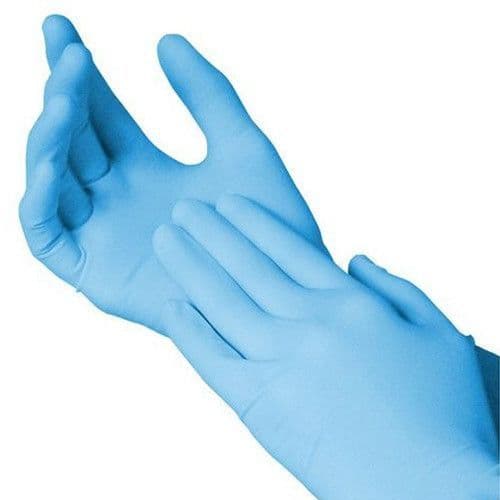
What Is the Best Thickness for Nitrile Gloves?
Nitrile gloves are swiftly climbing to the top of the popularity list for disposable gloves, as we've seen in many of our earlier posts. Their increased usage is due to a variety of factors. Natural latex gloves offer numerous advantages that nitrile gloves also have, such as flexibility, dexterity, and a secure fit. However, since nitrile is a synthetic rubber and lacks the characteristics of latex that cause allergies, they completely remove the possibility of allergic responses. These gloves may be used in almost any application or sector due to their extreme versatility. They are robust enough to resist chemicals, tolerate grease, and have great puncture resistance, yet they are also fitted well enough to offer you the tactile sensitivity required for sensitive treatments.
First Comparison: Exam vs. Industrial
The first step in selecting the right nitrile glove for your application is to look at the two primary nitrile glove categories: industrial grade or medical grade. How the gloves will be utilised is the primary deciding element in which grade of nitrile glove to choose. The two nitrile glove grades are described below:
Industrial Grade: This kind of nitrile glove is best suited for tasks requiring the handling of corrosive substances like solvents and chemicals. This kind of nitrile glove is often utilised in the automotive, janitorial, and any other chemical safety-related sectors, including food service. The glove's high levels of puncture resistance and chemical resistance are its two key characteristics.
Exam or medical grade gloves are normally appropriate for usage in situations where there is a chance of coming into touch with bloodborne pathogens or other environmental pollutants. Hospitals, medical and dental offices, and labs often use this kind of nitrile glove. Medical grade gloves must pass stringent tests and adhere to strict FDA regulations in order to guarantee that they will offer the strength, durability, and barrier required for these applications. Because they completely eliminate the possibility of any allergies, nitrile gloves are also very popular in dental and medical offices.
How about glove colour and size?
Many individuals undervalue the significance of a properly fitting glove. It is strongly advised to try samples of disposable latex gloves online from different manufacturers if at all possible in order to determine the appropriate size. Your comfort and tactile sensitivity will improve with the right-sized glove in any situation.
Disposable nitrile gloves are available in a wide variety of colours, which is one of their best features. However, these hues go beyond simple fashion. There are several useful suggestions for utilising coloured nitrile gloves in the workplace to promote efficiency and safety. You can assist in differentiating glove sizes and aid in cross contamination prevention by color-coding your nitrile gloves. The most common colour of nitrile gloves is blue, which is useful for distinguishing them from latex gloves in medical settings. Black nitrile gloves are frequently used in industrial settings that contain oil and grime, such as automotive applications. This messiness is covered by the black gloves. Orange, green, or pink nitrile gloves can be useful in a variety of circumstances. Because the gloves are visible, you can tell when employees are wearing them, which increases safety compliance. You might put on two layers of nitrile gloves, the bright colour on the outside for further protection. In this manner, if a cut or puncture happens, the vivid colour is evident and you are informed that something is wrong.
Consider Other Glove Features
Glove Thickness: The majority of disposable nitrile gloves range in gauge, or thickness, from four to eight mil thick. Heavy duty industrial grade nitrile gloves will typically be 6 to 8 mils thick. The additional thickness will provide a thicker barrier of protection since industrial grade disposable gloves are often used in tough conditions. When dealing with chemicals, thicker gloves will provide a longer penetration time and higher rip resistance than thinner light duty nitrile. In general, you will discover a better degree of dexterity and flexibility the smaller the gauge, and vice versa.
Texture and Surface: If you require a nitrile glove with improved grip, search for one with a textured finish on the fingers and palm. This texture, which often has a diamond pattern, will improve grip in both dry and wet circumstances. The majority of nitrile gloves have a chlorinated finish that reduces stickiness and makes it simpler to put on and take off your hands.
When it comes to nitrile gloves, there are two often available options: powdered and powder free. The chlorinated or polymer finish is used on powder-free gloves. With this finish, putting on and taking off your gloves is simple and hassle-free. The powdered alternative is useful since it absorbs any excess moisture, making it easier to put on gloves, although it could leave some residue behind.
Be sure to keep all of these things in mind when selecting your next pair of disposable nitrile gloves so that you may work as effectively as possible. Check out this page for our selection of nitrile gloves.
Appreciate the creator